Understanding the terms and slang used when talking about the guitar is important for every guitarist.
This glossary of terms will explain every important guitar term you are likely to hear.
I’ve included a brief description of each term with pictures when needed. Links to useful guides and lessons for relevant terms are included if you need to learn more about the term.
Note: this glossary of terms doesn’t include guitar hardware terms. Find out the names of guitar parts in this guide.
Guitar Terms – A
Accent
An accent on guitar is when you emphasize a specific note or chord to make it stand out by picking or strumming it harder. An accent symbol of < in sheet music means to emphasize that note or chord.
A common way to use accents is to emphasize the beat. Picking or strumming each note or chord that falls on the beat helps build a rhythmic pulse to your music.
Accidental
An accidental is a symbol used in sheet music to indicate a change in a note as sharp, flat, or natural.
As an example, a sharp symbol (#) next to the note C would mean to play the note C#.
Action
Guitar action or action height is the distance between a guitar’s frets and the strings. Action height plays a major role in how comfortable a guitar feels to play.
The below photo shows the difference between a guitar with low action (left) and high action (right). Guitarists tend to prefer low action for better comfort.

Find out everything you need to know about action height and how to adjust it in this guide.
Alternate Picking
Alternate picking is when you pick the notes in a down-up-down-up pattern. You continue to alternate between down and upstrokes with your pick.
Alternate picking is the preferred picking style of countless guitarists. It’s a skill worth practicing.
Alternate Tunings
An alternate tuning is any tuning other than ‘standard tuning’ such as Drop-D tuning or Open-C. Alternate tunings allow you to play guitar in new ways that aren’t possible with standard tuning.
Find out all about Alternate Tunings in this guide.
Amplifier
A guitar amplifier or amp is a device you plug an electric or acoustic guitar into to access a range of different guitar tones. Amplifiers also allow you to play at higher volumes depending on their size and power.
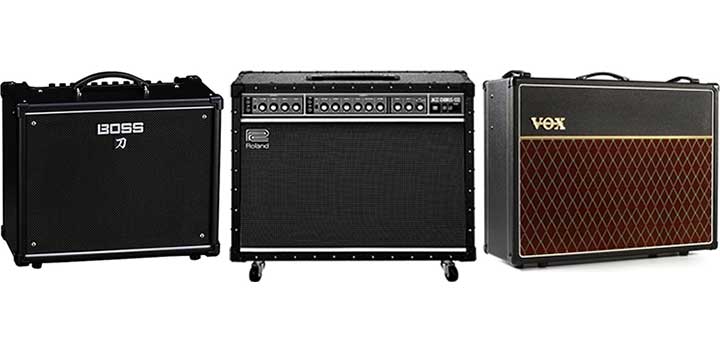
There are many different types of guitar amps available with a wide range of features.
Find out about types of guitar amplifiers in this guide.
Arpeggio
A guitar arpeggio is when you play the notes of a chord one at a time. Arpeggios are used in a wide range of styles from classical all the way to metal.
Artificial Harmonic
An artificial harmonic is a type of note performed by lightly touching the guitar string with a finger on your picking hand in a specific position while picking the note. Different artificial harmonics are possible for every note on the guitar.
Another way of thinking about artificial harmonics is that you’re playing a natural harmonic, but shifting the open string up.
Attack
Attack is the initial quality of a sound. The attack of a pick hitting the string will sound very different compared to the attack of your finger plucking the string.
Some guitar pedals also allow you to adjust settings for the attack of the effect.
Audio Interface
An audio interface is used to connect a guitar, microphone, or another instrument to a computer for recording. These small devices allow you to connect to a DAW (recording software) for studio-quality recordings.
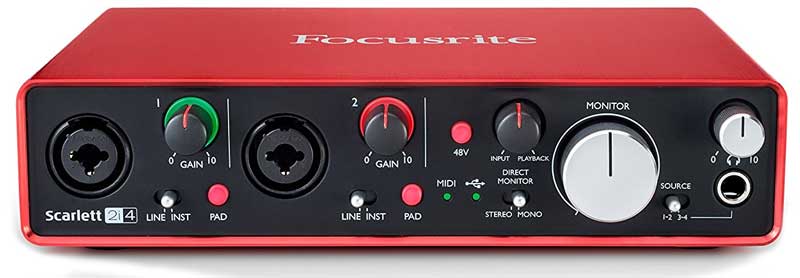
The above photo is of a very popular audio interface with guitarists, but many different shapes and sizes are available.
Find out about audio interfaces in this Guide to Recording Guitar at Home.
Augmented chord
An augmented chord is a Major chord where the fifth has been raised by a half-step. These chords are notated with a ‘+’ symbol or ‘aug’.
The fifth is an extremely stable-sounding interval, so raising it by a half-step turns the Major chord into a very unstable and uneasy sounding augmented chord.
Auto-Wah
An auto-wah is a type of guitar effect pedal that simulates the sound of a wah pedal without requiring you to control it.
An auto-wah is a type of filter effects pedal, similar to an envelope filter. Check out the BOSS AW-3 (link to Amazon) for an example of an auto-wah pedal.
Find out about auto-wahs and how they compare to other filter-based effects pedals in my Guitar Effects Course.
Guitar Terms – B
Barre Chord
A guitar barre chord is a type of chord where you flatten your index finger across the fretboard to form chord shapes higher up the neck.
Barre chords are moveable shapes, which means you can re-use the same shape all over the fretboard to form many different chords.
Barre chords are sometimes called bar chords or barred chords.
Bass (instrument)
A bass or bass guitar is a different type of instrument that has a lower sound than a typical guitar. While there is a big overlap in technique and gear between bass and guitar, they are two different instruments.
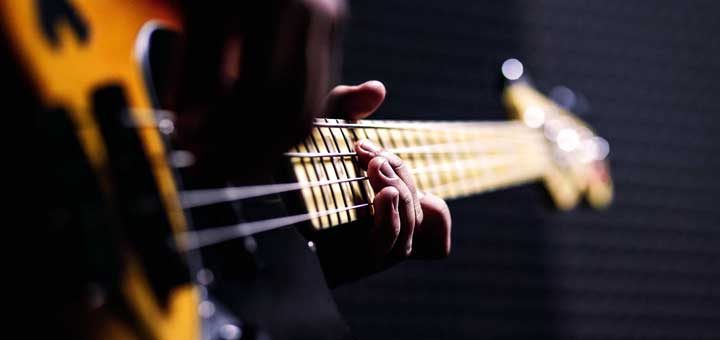
If you are interested in learning to play bass, check out these simple bass exercises.
Bass (tone)
Bass can be thought of as low-sounding notes on your guitar or as the low-end frequencies in your guitar tone. Guitar amps tend to include a bass knob, which adjusts the amount of low-end frequencies you hear as you play.
Bass Clef
A Bass Clef or F Clef is the symbol used in sheet music for low range instruments such as bass guitar. Guitar tends to use a Treble Clef or G Clef but may use a Bass Clef for low-tuned guitars.
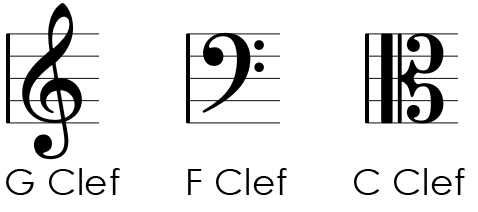
Find out more about these symbols in my guide on how to read Standard Notation.
Beat
A beat is a way of splitting up music into the rhythmic pulse you tend to hear or feel. The majority of music has four repeating beats, which you count as 1 2 3 4 1 2 3 4.
Some music may use a pattern of three repeating beats, while other styles can take a more complex approach.
The beat of the music is shown in sheet music with a time signature.
Bend
A bend is a guitar technique where you push or pull a string enough to change the pitch of a note. If you bend the string far enough, you can raise the note to another specific pitch.
The below transcription shows the notation used for a bend. In this example, you play the 7th fret note and bend it until the pitch is raised by a whole step.


Find out more about bends in my Guide to Reading Guitar TAB.
BPM
BPM stands for Beats Per Minute and is a way of measuring the tempo of a piece of music. The fast the song, the higher the BPM.
A song with a BPM of 60 would have one beat per second. A song with a BPM of 120 would have two beats per second.
Some guitar effect pedals such as delay will use BPM to control the effect. Other effect pedals require you to use milliseconds (ms) instead of BPM. Find out how to convert BPM to ms in this guide.
Guitar Terms – C
Capo
A capo is a small device that clamps onto your guitar neck and presses against the strings. Placing a capo on your guitar allows you to play chords and riffs in a higher position.
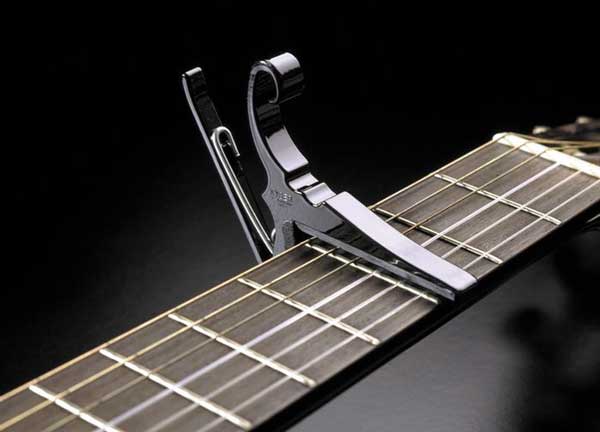

Capos are often used to change a song to fit with a singer’s vocal range. They can also be used to use open chord shapes anywhere on the fretboard.
There are many different types of capos, so find out everything you want to know about capos in this guide.
Chord
A guitar chord is when you play three or more notes at the same time. There are many different types of chords and each type creates a different type of sound.
Chord Diagram
A chord diagram is a visual way of writing how to play a guitar chord. Chord diagrams are an easy way to learn how to play a large number of chords and are found in sheet music.
As an example, the below chord diagram shows how to play the open chord G Major.


Learn how to read chord diagrams in this guide.
Chord Progression
A chord progression is when you play a number of different chords in a row in a repeating pattern. Many songs are written with a three or four-chord progression.
Chord progressions can be as simple or as complicated as you like.
Chorus
Chorus is a type of modulation guitar effect that is used on electric and acoustic guitar (when plugged in). A chorus pedal works by slightly modulating the signal. This can make the tone sound thicker or it can give it a shimmery quality.
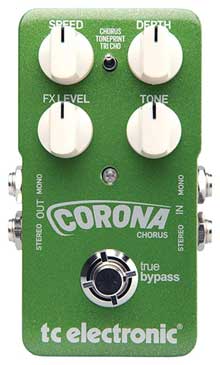

A chorus pedal can add some color or life to a clean tone, or it can be used with a drive tone.
Find out about chorus and best chorus pedals in this guide.
Chromatic
Chromatic is the term for notes outside of a key. These notes aren’t necessarily wrong to play, but playing a lot of chromatic notes can completely change the feel of a piece of music.
If you were to play every note on the fretboard, you would be playing a chromatic scale.
The term chromatic is often used with guitar tuners to let you know that they can tune to any note you want.
Circle of Fifths
The Circle of Fifths is a visual way of showing how the different scales and key signatures work. All 12 musical notes are arranged in a circle and arranged in fifths when you move clockwise through the circle.
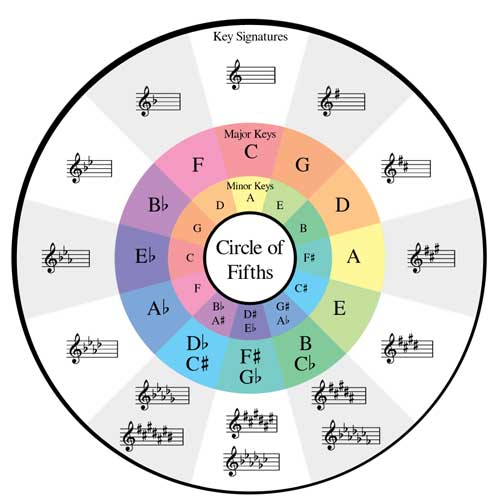

It’s a handy way of seeing how scales relate to each other.
Compressor
A compressor is a type of dynamics effect that gives you control over the dynamic range of your sound. In simple terms, a compressor evens out your volume level and makes soft parts louder and loud parts softer.
A compressor pedal is an incredibly useful tone-shaping tool and is used by countless electric and acoustic guitarists.
Find out everything you need to know about compressors and the best compressor pedals in this guide.
Consonance
Consonance is the term given for guitar chords that have a stable sound. Major and minor chords feel stable when you play them and are said to be consonant.
If a chord sounds uneasy, that’s not a consonant chord and we call that dissonance.
Counterpoint
Counterpoint is when you have two different melodies at the same time. Imagine a simple rising melody and a falling melody played at the same time. That’s counterpoint as both melodies aren’t following the same path.
If two guitarists play a melody at the same time, it isn’t counterpoint. It is only counterpoint if the two melodies differ in direction in some way.
Guitar Terms – D
DAW
A DAW or Digital Audio Workstation is a piece of software used for recording and mixing musical instruments. Software such as Pro Tools, Cubase, Studio One, FL Studio, Garage Band, and Reaper are all popular DAWs.


Any DAW is an incredibly powerful piece of software you can use to record full songs when paired with an audio interface.
Find out everything you would want to know about DAWs in this guide.
Delay
Delay is a type of guitar effect where your guitar signal is repeated in various ways. Delay is often mistaken for echo, which sounds similar, but is created in a very different way.
Delay is possibly the most popular guitar effect with both acoustic and electric guitarists.
The below photo shows an example of the different types of delays available in many guitar pedals.
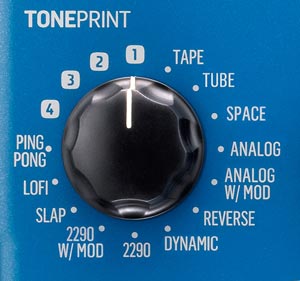

Find out everything you would want to know about delay pedals in this guide.
Diatonic
Diatonic is the term for when you play entirely within a standard scale. If a song is in the key of G and you only play the notes in the G Major scale, you are playing diatonic.
Dissonance
Dissonance is the term given for guitar chords that sound uneasy or unstable. Diminished or augmented chords feel unstable and are said to be dissonant.
If a chord sounds stable, it is said to be consonant.
Distortion
Distortion is a type of guitar effect that amplifies the signal until it breaks up and distorts. There are different types of distortion pedals to produce different types of distortion.
Distortion is also the general term used to describe a driven guitar tone whether the actual pedal used was distortion or overdrive.
Learn the difference between distortion, overdrive, and fuzz in my Guitar Effects Courser here.
Downstroke
A downstroke is when you take your guitar pick and pluck the string in a downward direction. You can play chords or single notes with a downstroke.
Drop-D Tuning
Drop-D Tuning is a type of alternate tuning where you change the low E string down to a D. All the other strings remain the same, so you end up with D A D G B E.
Drop-D is the most popular alternate tuning and there are countless songs that use Drop-D.
Find out everything you would want to know about Drop D Tuning in this guide.
Dynamics
Dynamics is how hard or soft you play the guitar. The range in volume you can play on guitar from the softest note to the hardest strum is the dynamic range.
Guitar pedals said to have a wide dynamic range allows you to widely vary the volume of what you play. Guitar tones with a tight dynamic range will limit your guitar volume to a close level.
A good way to learn about dynamics is to read up on compressors.
Guitar Terms – E
Ear Training
Ear Training is the practice of training your ears to identify notes, intervals, chords, and scales. By working through drills and exercises, you can improve your aural skills to the point where you can learn to play music completely by ear.
Find out more about Ear Training in this guide.
Economy Picking
Economy picking is a picking style that is based on alternate picking. The picking direction follows the direction you move across the strings.
When playing repeated notes on one string, you play alternate picking. Then when you change to a different string, the direction you pick depends on which string you’re moving to.
For example, if you’re changing from the 2nd string (B) to the 1st string (E), you would play a down pick. If you’re moving in the opposite direction, you would play an up pick.
Effects Pedal
An effects pedal or stompbox is a device you place on the floor that can change your guitar tone. There are many different types of effects pedals and each type can dramatically change your guitar tone.
Guitar pedals can come in many different shapes and sizes. Pedals can be connected together to form a chain of effects as shown below.
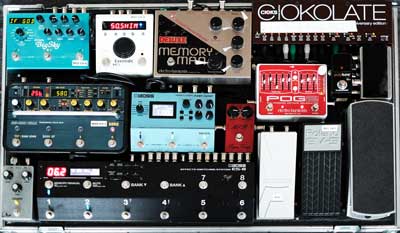

Learn about every type of guitar effect pedal, how they work, and how to use them in my comprehensive Guitar Effects Course.
Electric Guitar
An electric guitar is a type of guitar that is meant to be plugged into a guitar amp. There are many different shapes and sizes of electric guitars to suit different styles of music.
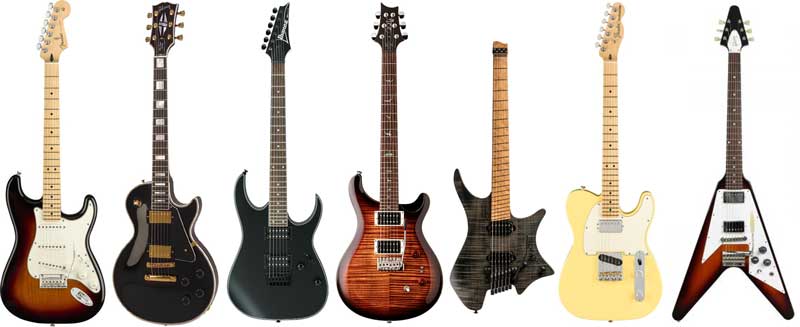

Electric guitars can access a wide range of tones and effects to suit different styles of music.
Find out about all types of guitars in this guide.
Enharmonic
An enharmonic is a note that can be written in more than one way. The note F-sharp (F#) and G-flat (Gb) are the same pitch, but can be written in different ways.
Learning how to find enharmonic notes on the fretboard is important when you want to learn how to read music.
Learn how to memorize the notes on the fretboard in this guide.
Envelope Filter Pedal
An envelope filter pedal is a type of effect that sweeps through a filter based on how hard you pick the strings.
Funk guitarists often use envelope filters to add to their funky rhythmic sounds.
Learn how to use envelope filters and hear them in action in my Guitar Effects Course.
EQ
EQ or Equalization is a way of controlling different frequencies to shape your guitar tone. Guitar amps usually have a set of EQ knobs to control bass, mid, and treble frequencies.
EQ pedals are available to shape the frequency range of your guitar tone.
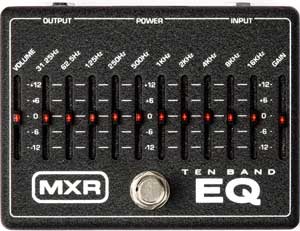

In the above photo, you can see that there are slides to boost or cut different frequency ranges to shape your guitar tone.
Guitar Terms – F
Fanned Frets
A guitar with fanned frets have frets that aren’t parallel to each other. Instead, the frets fan out across the fretboard. Guitars with fanned frets are also called multi-scale guitars.


Guitars with fanned frets are played in the same way as normal guitar frets. The only difference is with how they feel and sound.
Find out all about fanned frets in this guide.
Filter Pedals
Filter pedals are a range of guitar effects that include auto-wahs and envelope filters. These effects apply a filter on the guitar signal and can completely change the guitar tone.
Fingerstyle
Playing fingerstyle is when you play without a pick. Guitarists who play fingerstyle tend to play a lot of arpeggios and pluck multiple strings at the same time that wouldn’t be possible with a pick.
Finger Picks
A finger pick is a type of pick that you place over your fingers. Instead of plucking the strings with your fingers, the finger picks pluck the strings.


Finger picks allow you to play fingerstyle, while completely changing the attack on the strings and the tone.
Different materials are available for finger picks to change the guitar tone.
Flanger Pedal
A flanger pedal is a type of modulation effect that can add a metallic jet-engine like sound to your tone. They can be used in subtle or extreme ways depending on what type of tone you’re after.
Flangers aren’t as popular as phaser pedals because they tend to be very distinctive, which can make them too distracting in songs.
Hear how flangers compare to phasers and other modulation effects in my Guitar Effects Course.
Flat
A note is flat when it is lower in pitch than normal. When talking about tuning a guitar, a flat note is out-of-tune and needs to be raised to correct pitch.
When talking about notes in general, a flat note is a semitone (half-step) lower than the natural note. So the note A-flat (Ab) is one fret down from the note A.
Fuzz Pedal
A fuzz pedal is a type of distortion that creates a distinctive sound. Fuzz pedals are incredibly popular and were iconic in 60s and 70s rock.
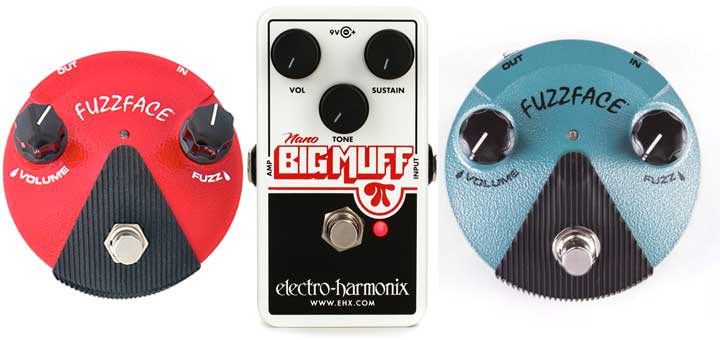

Fuzz pedals often sound completely different than a typical distortion pedal, which makes them incredibly fun to play.
Find out about fuzz and the best fuzz pedals in this guide.
Guitar Terms – G
Ghost-Note
A ghost note is a muted note played by lightly resting your fretting hand against the strings. They are notated by an ‘x’ in Guitar TAB.
Ghost notes can be played on a single string or across multiple strings.
Gig
A gig is a live performance or concert. Musicians use the term gig in the same way as the term job. While people going to concerts can also refer to it as a gig, although it isn’t a job for them.
Grace Note
A grace note is when you play a short or soft note immediately before another note. These notes aren’t part of the melody, but they add character or expression to the main notes in the melody.
Guitar Cable
A guitar cable is used to connect an electric or acoustic guitar to guitar pedals or a guitar amp.


There are a few different types of cables guitarists may use, so learn about the different types in this guide on guitar cables.
Guitar TAB
Guitar TAB or Tablature is a way of writing music for guitar. Guitar TAB uses lines and numbers to represent guitar strings and frets. Symbols are used to indicated different techniques.
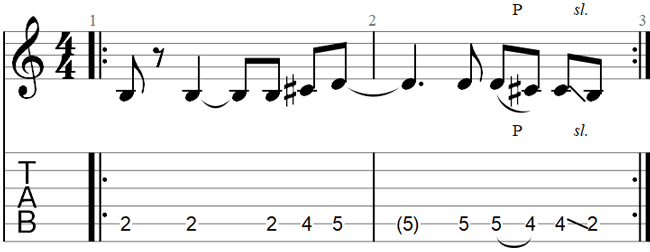

There are many websites where you can find Guitar TABs for a wide range of songs.
Learn how to read Guitar TAB in this guide.
Guitar Pro
Guitar Pro is a program you can use to view, edit, and playback music transcriptions. It includes both Guitar TAB and Standard Notation to view the transcriptions.
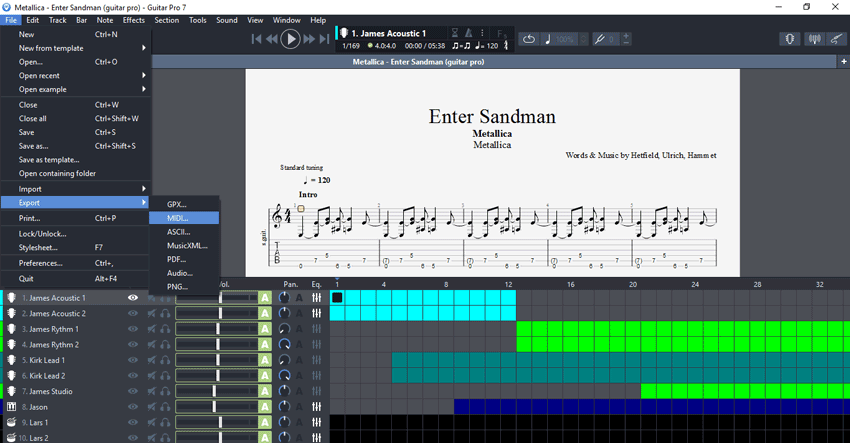

Find out more about Guitar Pro 8 in my comprehensive review.
Guitar Terms – H
Half Step
A half-step or half-tone, or semitone is one fret distance on guitar.
Hammer-on
A hammer-on is a type of guitar technique where you pick the first note, then press your finger onto a higher note on the same string without picking the string again.
A hammer-on is a type of legato technique.
Harmony
Harmony is when you play more than one note at a time. If one guitarist plays a melody and another guitarist plays the same or a similar melody, they are playing in harmony.
There are many ways you can create a harmony and there can be more than one harmony playing at the same time (eg: a ‘three-part’ harmony).
Harmonizer Pedal
A harmonizer pedal is a type of pitch-based effects pedal that creates a harmony on top of what you play on guitar. Harmonizer pedals allow you to choose between different intervals for different sounding harmonizers.
An octave pedal is a simple type of harmonizer pedal that focuses on one type of interval: the octave.
Guitar Terms – I
Interval
An interval is the distance between any two notes on guitar. Intervals are the building blocks of music that form chords and scales when put together.
Find out everything you need to know about intervals in simple language in this guide.
Intonation
Intonation is how in-tune your guitar is with itself. A guitar with bad intonation will sound out-of-tune, even if the strings are perfectly in tune.
Find out about intonation and how to adjust it in this guide.
Inversion
An inversion is when the notes of a chord are rearranged so the lowest sounding note isn’t the root note. Chord inversions can sound different than the ‘standard’ chord form while still remaining the same chord.
Guitar Terms – J
Jam
Jamming is when you play with other musicians. Some guitarists think of jamming as any time you’re playing with other musicians (eg: playing songs), while other guitarists only think of jamming as improvising. In other words, when you’re making things up on the spot with other musicians.
Guitar Terms – K
Key
You are playing in a key when a song or jam follows a specific scale. For example, if a song is written using the C Major scale, we say it is in the key of C.
The key can change during a song and we call that a ‘key change’.
Key Signature
A key signature is a symbol used to show on sheet music what the current key is. Sharps and flat symbols are used to the left of the time signature to indicate the key signature.
In the below example, the flat symbol to the left of the time signature tells us that this piece is in the key of F.


The circle of fifths is a good way to learn key signatures.
Guitar Terms – L
Legato
Legato is the term used for a group of techniques that don’t involve picking the string. Hammer-ons, pull-offs, slides, and tapping are all legato techniques.
When these techniques are used together, we say that the guitarist is playing legato.
Lick
A lick is a short group of notes that stand out in a song. Lead guitarists play a lot of licks to fill in spaces in music or to construct solos.
Some guitarists use the terms lick and riff interchangeably, while other guitarists only think of licks as lead guitar parts and riffs as rhythm guitar parts.
Looper Pedal
A looper pedal or a loop pedal is a guitar pedal that records your playing and plays it back in a repeating loop. You can set when to start and stop recording, then the looper will repeat that recording over and over.
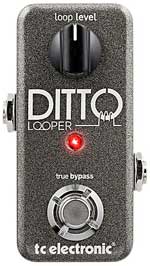

Loopers are incredibly useful tools you can use in performances, at home for jamming, or as a practice tool.
Find out more about looper pedals in this guide.
Guitar Terms – M
Major
Major is a term used for a type of chord or scale. There are many different Major chords and scales and they are all usually described as having an upbeat or bright quality.
It’s common for musicians to call Major chords ‘happy’ and minor chords ‘sad’, but those aren’t very accurate labels. It is very easy to make a Major chord sound sad and a minor chord sound happy.
Think of Major chords as ‘bright’ sounding chords.
Melody
A melody is a series of single notes strung together to form short or long ideas, themes, or tunes. How the melody sounds depends on the scales used and any other parts playing in harmony.
MIDI
MIDI stands for Musical Instrument Digital Interface. MIDI is a way for musical technology to interact with each other. Guitarists tend to use MIDI to control pedalboards. MIDI is able to sync up different time-based pedals such as delay pedals so everything works together.
Guitarists can also buy MIDI pickups to convert their guitar signal into MIDI, which can then be used in a massive range of synthesizers for non-guitar sounds.
Find out more about MIDI in this guide.
Minor
Minor is a term used for a type of chord or scale. There are many different minor chords and scales and they are all usually described as having a dark quality.
It’s common for musicians to call Major chords ‘happy’ and minor chords ‘sad’, but those aren’t very accurate labels. It is very easy to make a Major chord sound sad and a minor chord sound happy.
Think of Major chords as ‘dark’ sounding chords.
Modes
Modes are when you take a scale and use it in a different context. There are seven modes derived from the Major scale. These seven modes are Ionian, Dorian, Phrygian, Lydian, Mixolydian, Aeolian, and Locrian.
The easiest way to think about modes is that our ears hear a scale by how it relates to the root note. So if we take the scale C Major, it will sound different if we play it over a C Major chord compared to if we play it over an E minor chord. The scale stays the same, but what we hear changes.
We give the scale different names to match what we hear. So if we play the C Major scale over a C Major chord we call the mode C Ionian. If we play the C Major scale over an E minor chord we would call the mode E Phrygian. Same notes, but different contexts, so we get different modes.
Modulation
Modulation is a type of guitar effect that takes the guitar signal and repeatedly changes it slightly. Phasers, flangers, and Uni-Vibe are three very popular types of modulation effects.
You can learn about all types of modulation effects, how they work, how to use them, and what they sound like in my Guitar Effects Course.
Guitar Terms – N
Natural
Natural is the symbol used to change a note in sheet music from a sharp or flat, to the natural pitch. For example, if you play an F# and then want to play an F, a natural symbol is used to tell you not to play it sharp.
In the below example, you can see how natural symbols work.


To understand the above example and see more details on how these symbols work, check out this guide on how to read Standard Notation.
Natural Harmonic
A Natural harmonic is when you lightly touch the string in certain positions with your fretting hand, then pick the string. For example, if you lightly touch the string over the 12th fret and pick the string, you will hear a note ring out. That is a natural harmonic.
There are many different types of natural harmonics across each string.
Noise Gate Pedal
A noise gate pedal is a pedal that cuts off the signal when you stop playing to get rid of hum or background noise. It is often used with high-gain amp settings to cut back on noise.
Learn the difference between noise gates and noise suppressors in my Guitar Effects Course.
Note
A note is any musical pitch you can play on guitar. If you play multiple notes at the same time, we call it a chord. If you play one after the other, we call it a melody or scale.
There are 12 notes in western music.
Guitar Terms – O
Octave
An octave is a full circle through all 12 notes. If you play the low open E string, then play the 12th fret on the same string, both notes are E, but they’re an octave apart.
An octave is 12 frets distance on a guitar.
Octave Pedal
An octave pedal takes your guitar signal and either raises it in pitch by an octave or lowers it in pitch by an octave. Then it can mix the two signals together as you want.
Some octave pedals can mix in multiple octaves at once such as the very popular EHX POG2 as shown below.
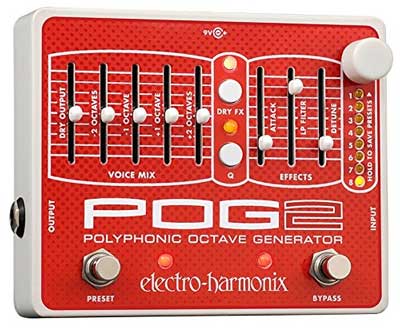

Playing with an octave pedal can allow you to create organ-like tones and interesting effects that wouldn’t be possible on a regular guitar.
Check out my review of the EHX Micro POG to learn more about this type of effect and different options.
Open Chord
An open chord is a guitar chord that makes use of open strings. Open chords are the first chords most guitarists learn because they are easier to play than barre chords.
Countless songs use open chords, so learning a few simple chords is all you need to play a lot of songs.
Check out these simple open chord songs to start learning some easy strumming songs.
If you want to learn some open chords, check out this guide on how to practice chords.
Open Tunings
Open tunings are a type of alternate tuning that tunes the strings in a way that form a chord when you strum all open strings. Open tunings are very popular with slide guitarists, as you can play full chords with a guitar slide.
Check out this guide to Open C Tuning or Open G Tuning to learn about open tunings and learn some great open tuning songs.
Overdrive Pedal
An overdrive pedal is a type of gain pedal that is designed to push your amp to the point where the signal breaks up (distorts). Overdrive and distortion are similar but can produce very different tones.
Learn the differences between overdrive, distortion, and fuzz in my Guitar Effects Course.
Guitar Terms – P
Palm Muting
Palm-muting is a technique where you rest the palm of your picking hand lightly on the strings. This slightly mutes the strings and creates a chugging sound.
When combined with a drive tone, palm-muting can get your playing a very percussive and powerful sound. Palm-muting is used across many styles of music in different ways.
Passing Tone
A passing tone is when you play a chromatic note in between two notes from a scale. While passing tones are outside of the scale, they can be used in effective ways in your improvising.
Pentatonic Scale
The pentatonic scale is a five-note scale used in a lot of styles of music. Most solos and lead parts you hear in rock music are built with the pentatonic scale in mind.
Because the pentatonic scale is easy to learn, a lot of guitarists first learn to improvise using it. This can lead to problems, so if you feel you’re stuck, find out how to break out of the pentatonic box in this guide.
Perfect Pitch
Perfect pitch is the ability to identify pitches by ear. Somebody with perfect pitch can hear a note and tell you exactly what note that is.
A very small number of musicians have perfect pitch and most don’t believe it can be learned. Fortunately, with ear training, you can learn relative pitch. Find out more in this guide on ear training.
Phaser Pedal
A phaser pedal is a type of modulation effect that creates a subtle sweeping sound in your tone. It is a popular guitar effect and works well on clean or drive tones.
Find out about phaser pedals in this guide.
p i m a
The letters p i m a are used in sheet music to label your fingers for fingerpicking.
p = thumb, i = index, m = middle, a = ring
Sometimes a fourth finger is needed and it tends to use the letter c.
Learn some easy fingerpicking patterns in this guide.
Pick or Plectrum
A guitar pick or plectrum is a small plastic (or other materials) triangular piece that is used to pick and strum the guitar strings.
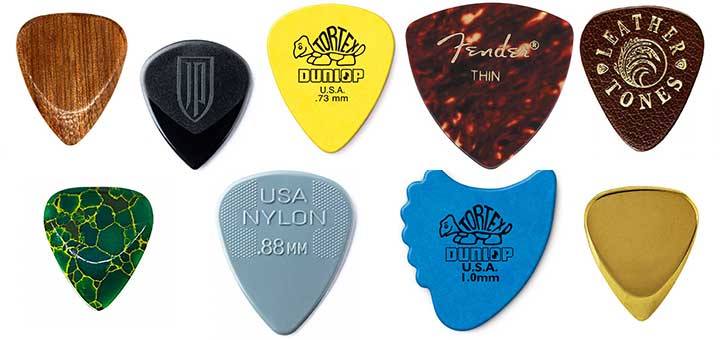

Guitar picks can come in many different shapes, sizes, thicknesses and materials to suit different styles of music and playing styles.
Find out everything you would want to know about guitar picks in this guide.
Pinch Harmonics
A pinch harmonic is when you use your picking hand to dig into the string when you pick it, which ‘pinches’ the string between the pick and your fingers. When done correctly, a harmonic rings out.
Pitch
Pitch is another name for note. The technical definition is that it’s a specific frequency of sound vibration.
When you hear a musician talk about pitch, they’re talking about a specific note. Sometimes musicians will use the term pitch to talk about whether something is in tune or not (eg: that bend was off-pitch).
Pitch Shifter Pedal
A pitch-shifter pedal is a type of guitar effect that can change the pitch of what you’re playing. The most popular pitch-shifting pedal is the DigiTech Whammy (read about it here), where you use an expression pedal to shift the pitch.


In the above photo, you can see that the pedal can be set to shift your guitar’s pitch by various intervals.
Power Chord
A power chord is a three-note chord using the root, fifth, and octave. It can be played with only the root and fifth and achieve a similar sound.
Power chords are extremely popular with guitarists across many styles of music due to the stable sound they offer.
Pull-off
A pull-off is a type of legato technique and very similar to a hammer-on. While a hammer-on moves to a higher note, a pull-off moves to a lower note.
To perform a pull-off, you pick a note, then lift your finger off to a lower note without picking it again.
Guitar Terms – Q
Quarter Note
A quarter note is a one-beat note. Another name for a one-beat note is a crochet.
Learn about different note lengths and their names in this guide on reading music.
Guitar Terms – R
Relative Pitch
Relative pitch is the ability to identify chords, scales, intervals, and notes by ear. This ability is based on comparing two or more pitches so you can figure out the relative difference between them.
Relative pitch is a skill everybody can learn with enough training. Find out how in this guide on ear training.
Rest
A rest is a break in playing for a specific length of time. Think of rests as the opposite of notes. Instead of playing a note for a beat, you may need to rest for a beat before continuing to play something.
Find out what rest symbols look like in this guide.
Reverb
Reverb is a type of guitar effect that simulates playing in different environments. When using reverb, you can make your guitar sound like you’re playing in a large hall, small room, cave, cathedral, or other environments.


The above photo shows some of the different types of reverb available in guitar pedals. Reverb can be an incredibly fun effect to use and can completely change the vibe of what you play.
Find out more about reverb in this guide.
Rhythm
Rhythm is the pulse or pattern music follows. Having a good sense of rhythm is a crucial skill for every guitarist (even lead guitarists).
Rhythm is also the term given for lower-range guitar parts that use mainly riffs or chords.
Riff
A riff is a short phrase or idea that can be repeated over and over in a song. Some guitarists only think of riffs as low-end parts that have a rhythmic focus. Other guitarists see lead guitar ideas as riffs as well.
Learn some iconic and easy riffs in this guide.
Root
The root is the focus point or the starting point for a chord or scale. If you’re playing the C Major scale, the note C is the root. If you’re playing an E minor chord, the root note is E.
The root note is important to understand as our ears tend to hear everything as it relates to the root note.
Guitar Terms – S
Scale
A scale is a sequence of notes you can use to write a song or guitar part. Popular scales such as Major or minor scales use seven notes, but there are other types of scales that use more or less notes (eg: the pentatonic scale uses five notes).
Learning scales is an important part of developing your abilities as a guitarist.
Find out how to practice scales in this guide.
Scale Length
The scale length is the length of a guitar from the nut to the bridge. This is an important length to understand because different guitars can have different scale lengths.


Find out how scale length impacts playability and tone in this guide.
Setup
Setup is the term given for a guitar’s action height, intonation, and general condition. A guitar with a good setup will feel comfortable to play and will sound good. A guitar with a poor setup may feel awkward to play or won’t stay in tune.
The term factory setup is often used to describe how the guitar is set to play as it comes out of the factory.
Sharp
A sharp is a note one half-step (or semitone) higher than the natural note. So the note C-sharp (C#) is one half-step higher than the note C.
Learn how to read sharp symbols in music here.
Sheet Music
Sheet music is written music you can use to learn to play songs. Sheet music may include Standard Notation, Guitar TAB, chords, lyrics, or a combination.
Check out this guide for advice on where to find sheet music online.
Shuffle
A shuffle is a rhythmic pattern used to create a swaying or swing feel to the music. Shuffles are commonly used in blues.
Slide (accessory)
A guitar slide is a small cylinder made of glass, metal, or ceramic. You place a guitar slide over a finger on your fretting hand and press it against the strings.
Guitar slides create a unique sound that isn’t possible with your fingers alone. It is popular in rock and blues styles of music.
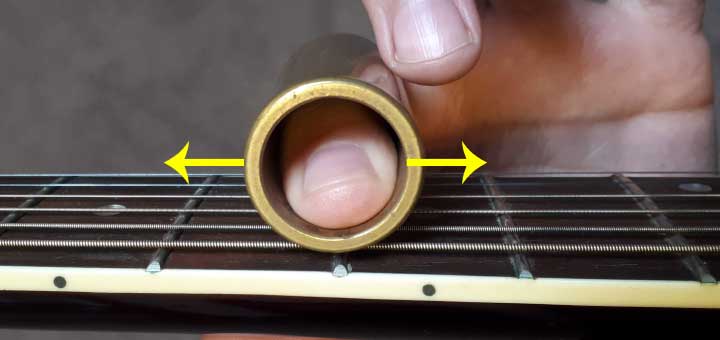

Learn how to use a guitar slide in this lesson.
Slide (technique)
A slide is a legato technique where you pick a note, then slide your finger up or down the string.
Staccato
Staccato is when you play notes or chords for a very short time. Staccato notes have a very short pulse sound and can be very effective when used properly to give music a rhythmic feel.
Staff
The staff is the horizontal lines used in sheet music.
Standard Notation
Standard notation is the name given for the typical way to write music across different instruments. Standard notation is one way you can read music for guitar.
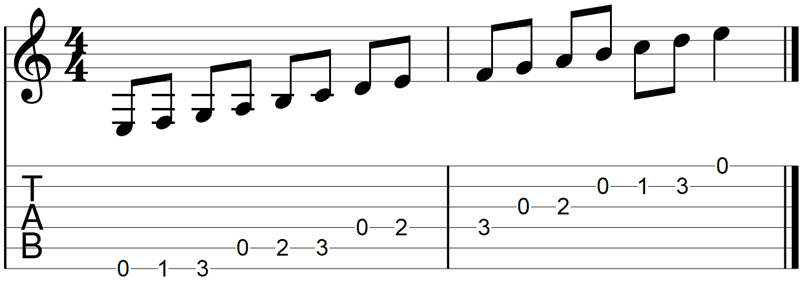

Find out how standard notation compares to other written forms of music for guitar in this guide.
Learn how to read standard notation in this guide.
Standard Tuning
Standard tuning is the most common way to tune a guitar. From the thickest string to the thinnest, the strings are tuned to: E A D G B E.
Any other tuning is considered to be an ‘alternate’ tuning.
Stompbox
A stompbox is another name for a guitar pedal. Stompboxes can come in many different shapes and sizes.
Strumming
Strumming is when you use a pick or your fingers to roll across the strings to play chords. Strumming typically follows a rhythmic pattern that repeats during a song.
Learn some easy strumming songs in this guide.
Suspended Chord
A suspended chord or sus chord is a type of triad that doesn’t use the third. For example, sus2 uses the root, second, and fifth. The chord sus4 uses the root, fourth, and fifth.
Suspended chords are popular with guitarists and many suspended open chord shapes are easy to play.
Sustain
Sustain is the term for how long something rings out for. A guitar said to have good sustain will ring out for longer than a guitar with poor sustain.
Different effects pedals can also impact sustain. Sustain is important for some styles of music and not important for other styles of music.
Sweep Picking
Sweep picking is a technique where you roll your pick over the strings as you play arpeggios. The technique is similar to economy picking, however it is usually used only to perform fast arpeggios.
Guitar Terms – T
Tablature
Tablature is another name for Guitar TAB (see earlier).
Learn how to read tablature in this guide.
Tapping
Tapping is a legato technique where you use your picking hand to hammer-on to notes. Two hand tapping involves using both hands to play hammer-ons and pull-offs.
Tempo
Tempo is the term for the pace or speed of a piece of music. Tempo is measured in BPM (beats per minute).
The tempo of a song can change throughout or it can remain constant.
Time Signature
A time signature is a symbol used at the start of a staff to indicate how may beats are in a bar and how long each beat is for.


In the above image, the 4/4 is the time signature. 4/4 time is the most common time signature you will see and it means there are four beats in the bar (the top number) and each beat lasts for a quarter note (the bottom number).
Tone
Tone can be another name for note or pitch, or it can be used to describe the sound your guitar makes.
Tonic
The tonic is another name for the root of a scale and is a very important note to consider when writing music.
Transpose
Transpose means to change the key of a piece of music. If you take a piece of music written in the key of C and change it so it is in the key of D, you have transposed the song.
The important point to remember is that the music (the melody and chord progressions used) stays the same, but everything is shifted up or down in pitch.
Transcription
Transcription is the term for writing out music. If you listen to a song and write down how to play it in Guitar TAB or Standard Notation, you are transcribing the song.
Treble
Treble is the term given for higher frequencies in a guitar tone. Most guitar amps will have a treble EQ knob to give you a way to adjust the treble in your signal.
Treble Clef
A Treble Clef or G Clef is the symbol used in sheet music for mid-range instruments such as guitar.



Find out more about these symbols in my guide on how to read Standard Notation.
Tremolo
Tremolo is a type of guitar effect that pulses your signal at a set speed. This speed can be adjusted and the severity of the pulsing can be adjusted in most pedals.
Tremolo can sound like a subtle wobbling or shimmering, or it can sound like a strobe-like pulse that completely cuts in and out at a rapid pace.
Learn more about tremolo pedals in this guide.
Tremolo Bar
A tremolo bar is a metal or carbon bar that extends from an electric guitar’s bridge. When you press down on the bar, it lowers your guitar’s pitch.


Different types of bridges can have different tremolo arms (also known as whammy bars).
Learn more about tremolo bars and other guitar parts in this guide.
Tremolo Picking
Tremolo picking is when you rapidly pick the same note over and over.
Triad
A triad is a three-note chord. Major and minor chords are the most common triads that use the root, third, and fifth.
Triplet
A triplet is when you play three notes in the time of two. For example, you may play three notes per beat or three notes spread over two beats. Triplets can completely change the feeling of a piece of music.
Tube
A tube is a component used in tube amps that were used before transistors were invented. Tube amps are popular with guitarists due to the warm tones they can create.
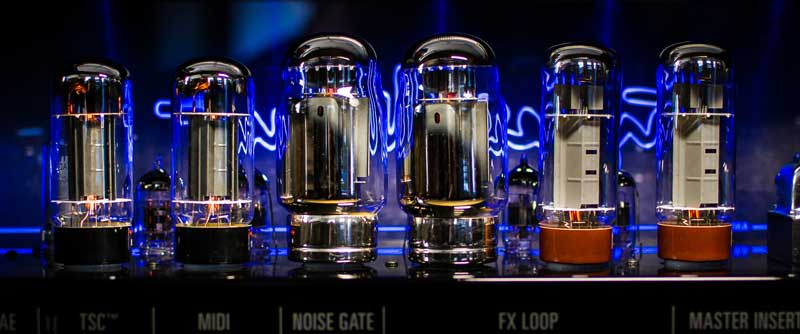

Amps with these glass vacuum tubes (also known as valves) are more expensive and heavier than other types of amps.
Learn more about tube amps and how they compare to other amps here.
Tuner
A tuner is a device used to help tune your guitar. Tuners are available in many different formats including pedals, smartphone apps, or physical units.


Check out the best guitar tuners in this guide.
Guitar Terms – U
Upstroke
An upstroke is when you strike a string from below in an upward direction. It is the opposite of a downstroke and can be peformed on a single string or across multiple strings.
Uni-Vibe Pedal
A Uni-Vibe pedal is a type of modulation effect that was popular in the 60s and 70s. Guitarists still use Uni-Vibe pedals today for the swirling and psychedelic tones it can create.
Learn more about Uni-Vibe pedals in this guide.
Guitar Terms – V
Valve
Valve is another name for the glass tubes found in some guitar amps.
Vibrato
Vibrato is a technique where you slightly rock a string back and forth to slightly raise and lower the pitch. When repeated over and over, it can give your guitar tone an expressive effect.
Vibrato is also a type of guitar effect that raises and lowers the pitch in a repeating pattern.
Volume Pedal
A volume pedal is an expression pedal used to raise or lower the volume of your signal. A volume pedal is a handy tool to control your guitar’s volume and it can also be used for volume swells.
Volume Swells
A volume swell is when you use a volume pedal or the volume knob on your guitar to fade your guitar’s signal in and out while you play. This is often called ‘violining’ as it can sound similar to a violin.
Guitar Terms – W
Wah Pedal
A wah pedal is a type of filter effect that you control with an expression pedal. By rocking the pedal back and forth, it creates a wah-wah sounding effect on your tone.
A wah pedal is possibly the most expressive guitar effect you can use as you can create vocal-like sounds while playing.
Learn more about wah pedals in this guide.
Whammy Bar
A whammy bar is a metal or carbon bar that extends from an electric guitar’s bridge. It is another name for a tremolo bar (as covered earlier).
Whammy Pedal
A whammy pedal is a type of pitch-shifting pedal. The most popular version is the DigiTech Whammy series, which can be used to shift your pitch up or down using an expression pedal or to harmonize your pitch.


Check out this list of songs using a whammy pedal to hear them in action.
Whole Note
A whole note is a four-beat note.
Whole Step
A whole-step is two frets distance on guitar or two half-steps.
Guitar Terms – X
X (in Guitar TAB)
An x in Guitar TAB is the symbol used for a percussive hit or ghost note (explained earlier).
Guitar Terms – Y
Y-splitter
A Y-splitter is a box or cable used to split your guitar signal from one path into two. This can be handy if you want to run two guitar amps at once or split your signal into two separate guitar pedal paths.
Guitar Terms – Z
ZZ Top? Know of a guitar term starting with Z? Let me know!
For more guitar terms, check out this Guide to Guitar Parts for a full list of guitar part names and what they do.
If there are any terms missing from the above list, let me know here.
